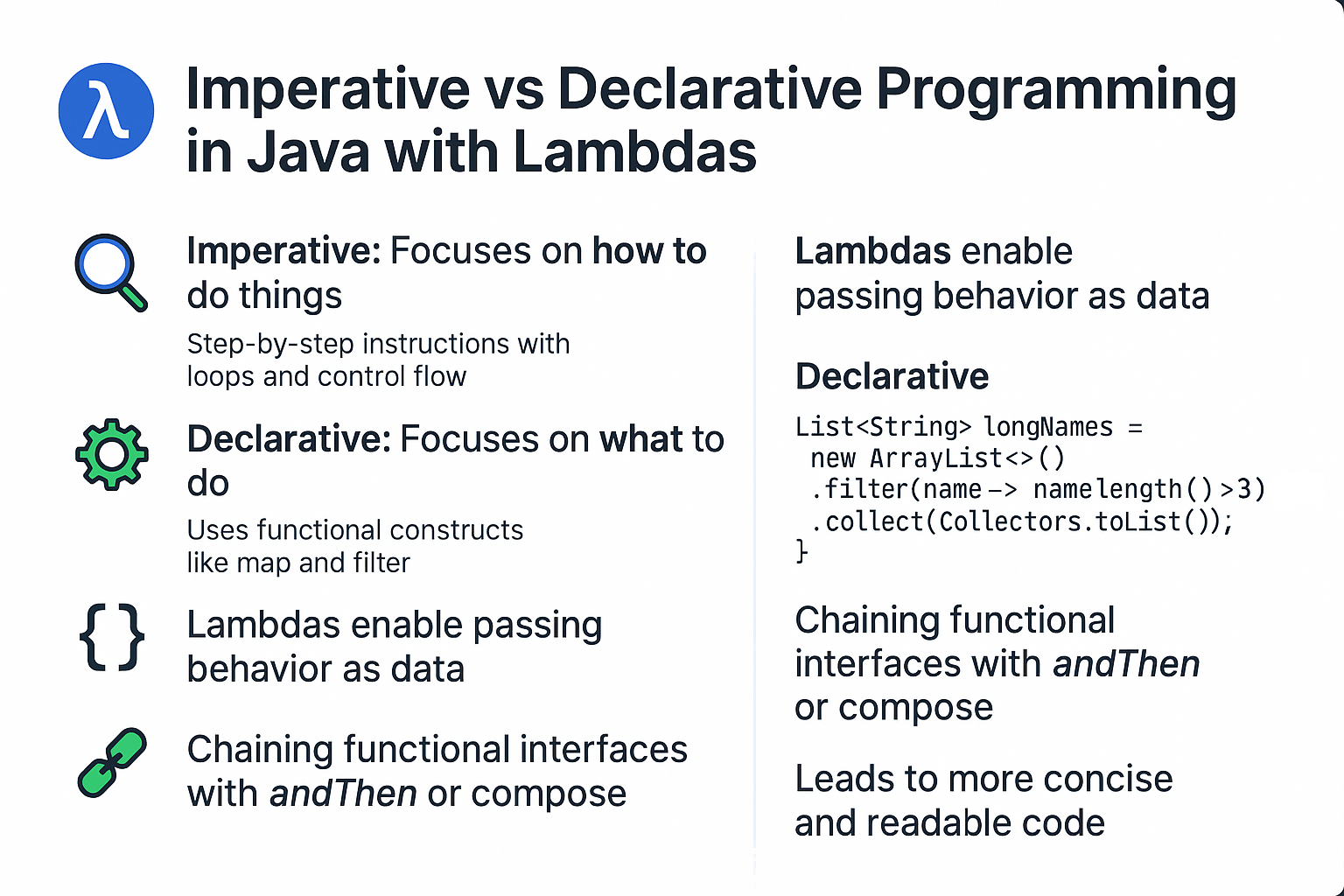In the world of Java programming, imperative and declarative styles offer two very different ways of expressing logic. While imperative programming focuses on how something should be done (step-by-step instructions), declarative programming emphasizes what needs to be done. With the introduction of lambdas in Java 8, developers gained powerful tools to write more declarative, concise, and expressive code.
In this tutorial, we’ll explore the contrasts between imperative and declarative styles, especially through the lens of lambda expressions, Streams, and functional interfaces. We’ll also examine performance implications, readability, maintainability, and practical patterns for writing better code.
What is Imperative Programming?
Imperative programming is about giving the computer explicit instructions on how to accomplish a task.
Example (Imperative Style)
List<String> names = List.of("Alice", "Bob", "Charlie");
List<String> upper = new ArrayList<>();
for (String name : names) {
upper.add(name.toUpperCase());
}
This is verbose but clearly shows how the task is performed.
What is Declarative Programming?
Declarative programming focuses on what needs to be achieved rather than how.
Example (Declarative Style with Lambdas and Streams)
List<String> upper = names.stream()
.map(String::toUpperCase)
.toList();
This is more concise and readable. It focuses on the transformation rather than iteration logic.
Lambdas: Enabling Declarative Java
Lambda expressions allow us to treat behavior as data — passing functions as parameters, returning them, or composing them dynamically.
Core Syntax
(parameter) -> expression
Common Functional Interfaces:
Function<T, R>– one input, one outputPredicate<T>– boolean-valued functionConsumer<T>– performs an action, no returnSupplier<T>– provides a result, no input
Imperative vs Declarative with Lambdas
Filtering Example
Imperative:
List<String> longNames = new ArrayList<>();
for (String name : names) {
if (name.length() > 3) {
longNames.add(name);
}
}
Declarative with Lambdas:
List<String> longNames = names.stream()
.filter(name -> name.length() > 3)
.toList();
Key Differences
| Aspect | Imperative | Declarative |
|---|---|---|
| Focus | How to do things | What to do |
| Style | Step-by-step, loops | Functional constructs (map, filter, etc) |
| Readability | May be verbose | Usually concise |
| Side Effects | Often present | Typically minimized |
| Error Handling | Inline (try/catch) | Requires special handling (e.g., peek) |
Chaining Functional Interfaces
Functional composition allows chaining behaviors:
Function<String, String> trim = String::trim;
Function<String, String> upper = String::toUpperCase;
Function<String, String> transform = trim.andThen(upper);
String result = transform.apply(" java ");
Refactoring Imperative to Declarative
Before:
List<String> result = new ArrayList<>();
for (String s : list) {
if (s != null && s.length() > 3) {
result.add(s.toLowerCase());
}
}
After:
List<String> result = list.stream()
.filter(Objects::nonNull)
.filter(s -> s.length() > 3)
.map(String::toLowerCase)
.toList();
📌 What's New in Java 8–21?
- Java 8: Lambdas, Streams,
java.util.function,CompletableFuture - Java 9:
Optional.ifPresentOrElse, JShell, modules - Java 11: Local variable syntax in lambdas (
var) - Java 17: Pattern matching (preview), sealed classes
- Java 21: Virtual threads, scoped values, structured concurrency
Functional Patterns
- Strategy Pattern with lambdas
- Command Pattern using
Runnable - Builder Pattern with chained lambdas
- Observer Pattern using
Consumer
Common Pitfalls
- Overusing lambdas – can reduce clarity
- Exception handling – harder inside streams
- Performance traps – boxing/unboxing, repeated lambda allocation
Conclusion
While imperative programming gives you low-level control, declarative programming with lambdas leads to cleaner, more maintainable, and often more performant code. Java offers the flexibility to blend both styles, letting developers choose what works best for each problem.
✅ Key Takeaways
- Use imperative style when control flow is complex or requires state management
- Prefer declarative style with lambdas for readability and maintainability
- Understand trade-offs: performance, debugging, exception handling
- Use built-in functional interfaces and Streams effectively
❓ FAQ
Q1: Can lambdas improve performance?
Yes, especially with parallel streams, but watch for autoboxing and lambda allocation.
Q2: Are lambdas garbage collected like objects?
Yes, they are objects and are GCed normally.
Q3: Is map().filter().collect() better than for-loops?
For readability and maintainability — yes. For raw speed — depends.
Q4: How do you handle checked exceptions in lambdas?
Use wrapper methods or custom functional interfaces.
Q5: Should I replace all loops with lambdas?
Not always — especially when control flow is complex.
Q6: What’s the difference between Function and Consumer?Function returns a value; Consumer performs an action with no return.
Q7: Can I chain Predicates?
Yes, use .and(), .or(), .negate().
Q8: How does effectively final affect lambdas?
Only effectively final variables can be captured inside lambdas.
Q9: Are lambdas thread-safe?
Lambdas themselves are stateless, but thread safety depends on surrounding logic.
Q10: When should I prefer method references over lambdas?
When the method reference is more concise and improves readability.
